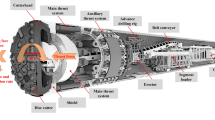Abstract
This paper presents the results of a study carried out on a 6.3-m-diameter exploratory tunnel excavated in hard rock by an open tunnel boring machine (TBM). The study provides a methodology, based on photographic analysis, for the evaluation of the particle size distribution of debris produced by the TBM. A number of tests were carried out on the debris collected during the TBM advancement. In order to produce a parameter indicative of the particle size of the debris, the coarseness index (CI) was defined and compared with some parameters representative of the TBM performance [i.e. the excavation specific energy (SE) and field penetration index (FPI)] and rock mass features, such as RMR, GSI, uniaxial compression strength and joint spacing. The results obtained showed a clear trend between the CI and some TBM performance parameters, such as SE and FPI. On the contrary, due to the rock mass fracturing, a clear relationship between the CI and rock mass characteristics was not found.














Similar content being viewed by others
References
Abu Bakar MZ, Gertsch L, Rostami J (2014) Evaluation of fragments from disc cutting of dry and saturated sandstone. Rock Mech Rock Eng 47(5):1891–1903
Altindag R (2003) Estimation of penetration rate in percussive drilling by means of coarseness index and mean particle size. Rock Mech Rock Eng 36(4):323–332
Balci C (2009) Correlation of rock cutting tests with field performance of a TBM in a highly fractured rock formation: a case study in Kozyatagi-Kadikoy Metro Tunnel, Turkey. Tunn Undergr Space Technol 24:423–435
Bieniawski ZT (1989) Engineering rock mass classifications. Wiley, New York
Bilgin N, Copur H, Balci C (2014) Mechanical excavation in mining and civil industries. CRC Press, Boca Raton
British Standard European Norm 933-1 (2012) Tests for geometrical properties of aggregates. Determination of particle size distribution. Sieving method. BSI Standards, London
Broch E, Franklin JA (1972) The point-load strength test. Int J Rock Mech Min Sci 9:669–697
Bruland A (1998) Hard rock tunnel boring, performance data and back-mapping. Project report 1E−98. University of Science and Technology Trondheim, Trondheim
Cardu M, Rispoli A, Bilgin N (2017) Innovazioni nello scavo meccanizzato in roccia. In: MIR 2017—16° Ciclo di conferenze di Meccanica ed Ingegneria delle Rocce “Innovazione nella progettazione, realizzazione e gestione delle opere in sotterraneo”. Celid, Torino, pp 55–78
Farrokh E, Rostami J (2008) Correlation of tunnel convergence with TBM operational parameters and chip size in the Ghomroud tunnel, Iran. Tunn Undergr Space Technol 23:700–710
Gertsch L, Fjeld A, Nilsen B, Gertsch R (2000) Use of TBM muck as construction material. Tunn Undergr Space Technol 15(4):379–402
Gong QM, Jiao YY, Zhao J (2006) Numerical modelling of the effects of joint spacing on rock fragmentation by TBM cutters. Tunn Undergr Space Technol 21(1):46–55
Hassanpour J, Rostami J, Zhao J (2011) A new hard rock TBM performance prediction model for project planning. Tunn Undergr Space Technol 26:595–603
Hoek E, Marinos P, Benissi M (1998) Applicability of the geological strength index (GSI) classification for weak and sheared rock masses—the case of the Athens schist formation. Bull Eng Geol Environ 57(2):151–160
International Society for Rock Mechanics (1978) Suggested methods for the quantitative description of discontinuities. In: Brown ET (ed) Rock masses. Rock characterisation testing and monitoring. Pergamon Press, Oxford, pp 320–363
Kemeny J (1994) A practical technique for determining the size distribution of blasted benches, waste dumps, and heap-leach sites. Min Eng 46(11):1281–1284
McFeat-Smith I, Fowell RJ (1977) Correlation of rock properties and the cutting performance of tunnelling machines. Proceedings of a conference on rock engineering. Newcastle University, Newcastle upon Tyne, pp 581–602
Nelson PP (1993) TBM performance analysis with reference to rock properties. In: Hudson JA (ed) Comprehensive rock engineering. Pergamon Press, Oxford, pp 261–292
Ozdemir L (1992) Mechanical excavation techniques in underground construction. Short course notebook, vol 1. Istanbul Technical University, Istanbul, pp 1–49
Parisi ME, Farinetti A, Gilli P, Brino L (2015) First results from the excavation of the Lyon—Turin Maddalena exploratory tunnel. In: ITA WTC congress and 41st general assembly; proceedings of international symposium, May 22–28, Dubrovnik, pp 0–11
Rispoli A, Ferrero AM, Cardu M, Brino L, Farinetti A (2016) Hard rock TBM performance: preliminary study based on an exploratory tunnel in the Alps. In: Ulusay R et al (eds) Rock mechanics and rock engineering: from the past to the future. Taylor & Francis Group, London, pp 469–474
Roxborough FF, Phillips HR (1975) Rock excavation by disc cutter. Int J Rock Mech Min Sci Geomech Abstr 12:361–366
Roxborough FF, Rispin A (1973) The mechanical cutting characteristics of the lower chalk. Tunn Tunn 5:45–67
Tuncdemir H, Bilgin N, Copur H, Balci C (2008) Control of rock cutting efficiency by muck size. Int J Rock Mech Min Sci 45(2):278–288
Acknowledgements
The authors want to thank TELT s.a.s., the owner company of the project, for the permission to publish the results of this study and for the support provided during the work performed at the Maddalena tunnel.
Author information
Authors and Affiliations
Corresponding author
Rights and permissions
About this article
Cite this article
Rispoli, A., Ferrero, A.M., Cardu, M. et al. Determining the Particle Size of Debris from a Tunnel Boring Machine Through Photographic Analysis and Comparison Between Excavation Performance and Rock Mass Properties. Rock Mech Rock Eng 50, 2805–2816 (2017). https://doi.org/10.1007/s00603-017-1256-5
Received:
Accepted:
Published:
Issue Date:
DOI: https://doi.org/10.1007/s00603-017-1256-5




